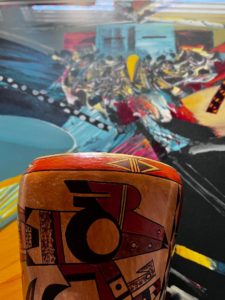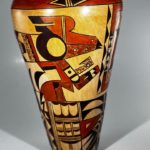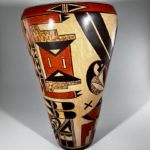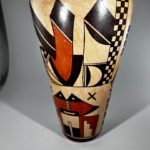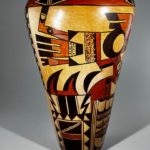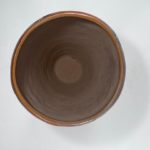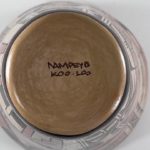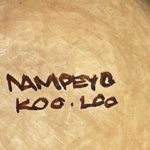This vase displays a mural of abstract birds, Hopi messengers to the gods. For me those birds also carry substantial emotions.
This is the last pot I bought directly from Rachael, who was gravely ill. I was able to visit her at her ancestral home in Polacca on November 5, 2022. What I had expected to be a short visit turned into a long one as we reminisced about our almost 40-year friendship. She began her journey to the underworld 18 days later.
Rachael made this jar for her husband, Claude Pahona. During our emotional visit Claude decided he wanted me to own it. For me this jar is a blessing vessel, carrying gratitude for my friendship with Rachael and Claude, pleasure in the beauty Rachael created over a long career as an artist, and my wish that her journey be peaceful and bring blessings to her people.
Form:
From the 2.5-inch base, the walls fan outwards 9.25-inches to just below the rim, where they slope inward to form a slight 0.5-inch lip surrounding a 5.375-inch wide mouth. Thus the width of jar 2022-14 is more than three times its small base.
The base is only somewhat thicker than the walls. The walls are even from base to lip and are thin relative to the jar’s size, evidence of a master potter. The interior has not been sanded smooth, but retains the marks left by Rachael’s gourd scraper. The jar fired very evenly, with only the hint of a blush near the rim on one side of the vase
Design:
Unusually the lip of jar 2022-14 carries a thick black framing line on the interior of the jar’s mouth, though ironically the pot bought just before this one had the same feature (2022-13). The exterior of the lip is encircled by a thick red band . Inset into this band at the four cardinal points is an element with an overall diamond shape composed of black isosceles triangles encased in larger unpainted triangles with a black edge. Two sets of these triangles are oriented with their bases facing each other but separated by four parallel lines, a three-lane “highway.”
The lower edge of this red band is marked by a thin black line. The bottom edge of the design panel is also marked by a thin black line. Below it is a thick black framing line that reflects the black framing line on the interior of the lip.
The design panel is 8.625-inches wide. Generally Rachael follows “Grandma Nampeyo’s” example and leaves considerable space around her designs. Here, however, the design elements are close together with only occasional patches of undecorated surface. Typically pottery from Hopi has a balanced design with the same elements repeated on opposite sides of a vessel. That is not the case here. On this jar design patterns do not repeat themselves; unique design elements appear as you rotate the vessel.
I generally describe the designs on a pot in detail, placing each element in its context. Given the non-repeating complexity of design on this jar, however, such a discussion would take so many paragraphs of that I think the beauty of the jar would be lost in the wordiness. Hence for jar 2022-14 I will more-generally describe the design. When Rachael discussed the jar with me in her home on November 5, all of the designs (with the exception of a few areas with geometric shapes) were explained as avian.

Rachael’s hands explaining the pot they made. Photograph by Claire Alexander
Side 1, photo above: Most recognizable is a 7.25-inch long bird place just below the rim band. Although abstract, this is the most realistic depiction of a bird on the vase. Bright-eyed and sharp-beaked, the bird on vase 2022-14 speeds to the right driven by bright-red wings above its body. At the center of its body is a large unpainted circle framed by a circular black frame of varying width. The rear of the body carries a segmented, intricate design, followed by a three-pronged red comb caped by long black tips: tail feathers. Appendix F contains design elements frequently used by Nampeyo. Under “Tails” I note “red base comb, black tipped and flanked by red pointed feathers.” The core of Rachael’s design here is the same, but she has innovated rather geometric flanking designs, one sharply bent. This bird is bordered by vertical strips of geometric design. To its rear is a checkerboard strip of 3 X 18 squares, alternately painted black or unpainted. In front of its beak is a series of black triangles, all pointing to the right. Just beyond their tips is a thin framing line outlining the next paned of design. The residual unpainted space between the series of triangles and this line forms a reflective set of unpainted triangles pointing left, creating background/foreground reversal.
Below this bird is a pileup of Tewa-Hopi design elements, some curved and sickle-shaped, some rectangular with internal stripes, some a collection of varying monochromatic feathers. Notice that Rachael again employs strips of black and unpainted triangles to frame the rectangular form. Notice also that just below the neck of the large bird there is a large L-shaped element incorporating a series of design elements. From one side of this “L” rises a squared-off crook with an embedded unpainted circle. During our discussion Rachael singled out this design as also being an abstract bird, the circle its eye.
Side 2, photo above:
As noted above, a strip of painted and unpainted triangles is positioned just to the right of the bird on Side 1. Just to the right of this strip is a red design like a squared-off “C,” a rectangle with three sides. Like the red rim-strip above, this design features embedded black designs internal to its long side. This design can be seen as a series of three unpainted rectangles with intruding triangles. The top and bottom rectangles have top and bottom black intruding triangles, the middle box having black triangles intruding from the sides. This design consequently forms another pattern of background/foreground reversal. External to the ends of this band of design are conjoint black triangles, forming a two-pronged form, and (again) background/foreground reversal with the surrounding red strip. Similar two-pronged elements grace the ends of this squared-off “C.”
Tucked inside this boxy “C” Is a black and red design, itself flanked by stippled, stepped rain cloud elements. This central design consists of a red square with two slit “eyes,” with black isosceles triangles intruding into the red from top and bottom. Small unpainted isosceles triangles are inset into the peaks of the black triangles.
Sides 2-3, photos above:
This panel is relatively simple, with two defined bird images, one above the other. The top bird is more disjointed. It displays two vertical wings, the central wing incorporating red and the right one monochromatic. To the left is the black head, with a circular eye and an abstracted beak. Rising from the neck is a pair of thick, black and sloped bands.
The lower bird was also identified by Rachael as an owl and this rendition is more easily recognizable than the version in the previous panel. The head is basically red and is a horizontal, notched, diamond shape. the central notch in the upper surface leaves two pointed shapes. The residual area created by the notch is painted black, creating two black triangles with embedded circular eyes. The edges of the lower half of the diamond are also painted black, creating black cheeks. The remaining elements are long, thin rectangles. The mouth is a black rectangle with an unpainted open mouth. An unpainted ladder-like strip with 10 short lines bridging the sides runs between from the notch between the eyes to the mouth, forming a beak. The core of the owl’s body is formed by two tail feathers with a common unpainted base and black tips. Flanking the body are two red wings that incorporate unpainted stepped rain clouds.
Between this owl and the bird above, are two large “X” elements.
Steve Elmore’s gallery represented much of Rachael’s work and Steve was a friend. About a pot with a similar design he wrote:
“This Hopi storage jar by Rachel Sahmie features a unique collage of many different Hopi designs that she has used over her long career. Here, Rachel is freewheeling with many different designs to create a complex mosaic inspired by ancient potsherds. This is one of the first jars Rachel made in homage to the potsherds. The jar has an exceptionally small base, something both Rachel and her mother Priscilla Namingha Nampeyo are known for (November 2022).”
The vase is signed “Nampeyo, Koo-Loo,” Tewa for “Nampeyo, Corn Clan.”
Design analysis:
The vase’s tall, fan-shaped profile makes it seem as if it has little weight and might float upwards. As it soars off its small base and expands, the shape reinforces the free-flight pattern of the abstract birds that decorate its surface.
The format of the large, abstract, bird in panel #1 and much of the design on jar 2022-14 is taken directly from the design on an ancient Sikyatki seedpot:
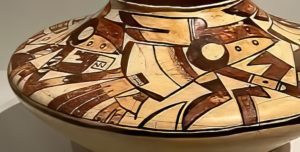
Sikyatki seedpot ca 1450-1625 CE, Fine Arts Museums of San Francisco (Catalog #2013.36.122)
Rachael has taken this design pattern and applied it to a very differently-shaped jar.
A friend of mine, Vincent Drucker, visited the deYoung Museum where this Sikyatki pot is on display as part of an exhibit. He spoke with a curator about the similarity of design between the ancient pot and Rachael’s pot. The curator responded with an email to Vincent:
“Thank you too for sharing the link about Rachel Sahmie’s pot! I had not known and it is wonderful to read. Bobby Silas [co-curator of the exhibit] interviewed her in the process of us making the exhibition and I sent her a number of photographs of the installation as a thank-you. I am delighted to know that they became a source of inspiration. I have added the article [catalog entry] to the object [Sikyatki pot] file; I really appreciate you sharing it with me.”
Because the design on vase 2022-14 is not symmetrical, it makes a different impression than most of Rachael’s pottery. As the vase is turned, its story unfolds, like a mural. Both Jake Koopee (2004-08) and Nathan Begaye (2014-04) experimented with mural-like formats, but such examples are rare.
Since the establishment of the Sikyatki Revival style at the end of the 19th century, most pottery from Hopi has displayed thick-above-thin framing lines at the top of the design panel and thin-above-thick framing lines at the lower edge of the design. This is only the second time I have seen a thick, black, upper framing line painted on the inside of a lip with the expected thin framing line drawn on the exterior. When viewed at an angle (the most common approach to this vase) both the interior black and the exterior red framing lines are partially seen with the same glance, adding variation and interest to the pot.
The circle at the center of the bird on side 1 acts as a bull’s eye, attracting and focusing a viewer’s attention. This bird is a near copy of the bird on the Sikyatki seedjar pictured above and is also stylistically related to the birds on plate 2020-09, that design defined by the decoration on an ancient Sikyatki canteen (Moulard, 2002:169).
The three-sided, rectangular, design on side 2 has a pattern that reminds me of strip beadwork created by tribes from the American plains. Its bent form also recalls the pattern of Navajo “Yeis” woven into rugs and painted by Ida Sahmie (Rachael’s sister-in-law) onto her pottery. The abstract squarish form encircled by this band of design is a very abstracted face, with a black triangular forehead, two slit eyes and a white triangular mouth. Rachael saw this as an owl. The stepped elements above and below it, like the same element on the wings of the owl in the next panel, represent prayed-for rain clouds. If, as Rachael said, all the non-linear designs on this vase are avian, this is the most abstract of the birds.
On both sides 1 and 2, background/foreground reversal adds tension and energy to the design.
The upper design on side 2-3 is a cubist bird, the thrust of its wings and that set of black stripes giving it a sense of upward motion. I see the monochromatic element at the rear of the bird as a vertical tail. The lower design is this panel is clearly an owl.
Early in her career Rachael created her own designs and often applied them to pots whose form she also created (2000-05 and 2003-04). Admonished by her mother Priscilla to stay with the old designs, Rachael switched strategies and thereafter stayed with traditional designs. She collected images of such designs from ancient shards she found on her frequent walks around Polacca, books, and images sent to her by pottery dealers and friends. Rachael had an intense creative energy about her and was uneasy when not making pots, quilts or cooking. This energy often woke her up at night and she would tell me “I just had to get up and do something. I had all these images in my head and I wanted to put my hands to work.”
Drawing from tradition and compelled by her artistic spirit, Rachael created pottery that had the same presence as the pottery of her great-great grandmother Nampeyo. As I fell in love with the artistry of Nampeyo, so too did I fall in love with Rachael’s work. For almost 40 years I looked over her shoulder as she created and she responded with friendship. Once created, a pot has its own personality and a life beyond its maker. Much like “Grandmother Nampeyo,” Rachael’s pottery continues to bring beauty to the world. Using simply the clay, water and plants of her desert home, and fired with sheep dung, Rachael made manifest the natural beauty of the Hopi mesas and the richness of Tewa and Hopi tradition and culture. She is missed; her pottery is treasured.
Postscript:
In 2008 Priscilla Namingha Nampeyo was terminally ill and her children gathered around her. Youngest daughter Bonnie is known for the quilts she makes and as they sat at their Mother’s bedside the four sisters (Jean, Nyla, Rachael and Bonnie) decided to make a quilt together. After Priscilla had passed, Rachael continued making quilts as well as pottery. Several of her quilts are in the National Quilt Museum and the Amerind Foundation Museum recently organized an exhibit featuring both Rachael’s pottery and her quilts. Occasionally Rachael texted me photographs of recently-completed quilts.
During our November 5 visit Rachael said she wanted to give me a quilt in honor of our long friendship. An extraordinary gift. The quilt is shown here at home on my bed:
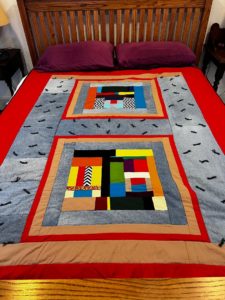
Notice the strong, vibrant colors. Difficult to discern in this photo is one strip of cloth featuring corn. In recent years Rachael signed her pots with the words “Nampeyo Koo.Loo,” Tewa for “Nampeyo Corn Clan.” Thus the small strip of corn in the quilt can be read as her signature.
I had strong emotions being with Rachael and Claud, crying and laughing, reminiscing about our friendship, responding to her generosity, holding her pottery, saying goodbye and then leaving her home. When we walked outside we were greeted by the most magnificent sunset I have ever seen:
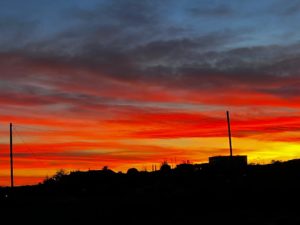
My emotions of the moment jumbled together. The vibrant colors of Rachael’s gift quilt capture the bright colors of the red-agate sunset. On the vase elegant birds rise through that same Hopi sky carrying prayers to the gods. When we parted Rachael was at the sunset of her life, a life creating beauty with her talent and hands. Beauty, Rachael, quilts, pottery and sunsets: my emotions are of one peace.
